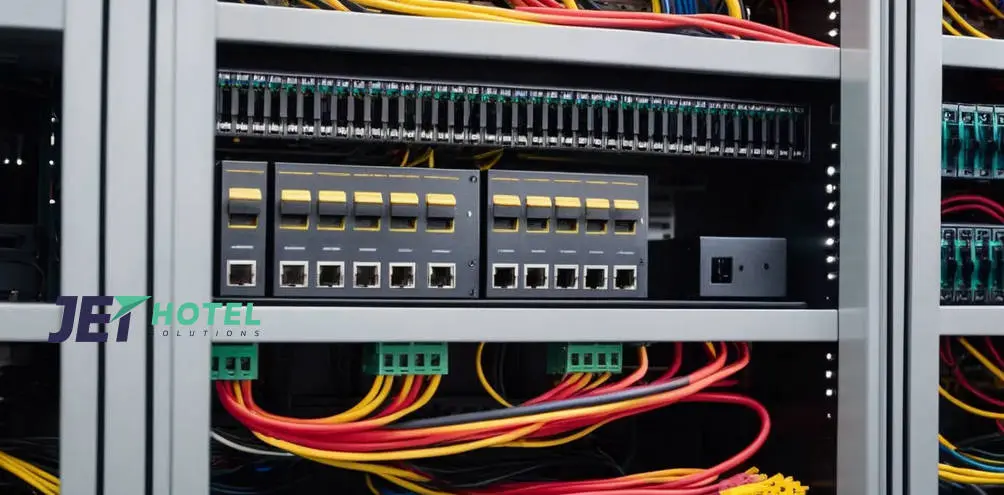Mastering Structured Cabling Box Terminations: A Guide for Hotel Technology Managers
Introduction
With regard to hotel management, technology serves as the backbone of daily operations. At Jet Hotel Solutions (https://www.jethotelsolutions.com/), we understand that a robust technological infrastructure begins with a well-planned structured cabling system.
This article dives into the critical aspects of structured cabling box terminations—a fundamental component in creating an efficient, reliable network that meets the high demands of the modern hospitality industry.
Understanding Structured Cabling
Structured cabling is an organized approach to wiring that supports multiple hardware uses and can be scaled to accommodate future upgrades and technology shifts. This system simplifies both the deployment and management of network devices and services, such as internet, cable TV, and VoIP, central to hotel operations.
Benefits for Hotels
Structured cabling systems offer unparalleled scalability, allowing hotel technology managers to add or modify their infrastructure with minimal disruption. This adaptability is crucial for hotels that need to expand their network capacity or integrate new technological services without overhauling the entire system.
Additionally, the reliability and organized nature of structured cabling ensure fewer errors and easier troubleshooting, leading to reduced downtime and improved guest satisfaction.
Preparing for Cabling Box Terminations
Before diving into the actual process of cable termination, it’s essential to gather the right tools and materials. Essential items include:
- Wire strippers
- Cable crimpers
- Punch-down tools
- Cable testers
- Patch panels
- Ethernet and coaxial cables
- RJ45 connectors
Choosing the right type of cabling involves understanding the specific needs of your hotel’s network. Cat6 cables are generally suitable for high-speed data transfer, while coaxial cables are ideal for video transmissions.

- Ethernet Cable Termination
- Cutting and Stripping the Cable: Measure and cut the Ethernet cable to the desired length, then carefully strip about 1.5 inches of the outer jacket, ensuring not to damage the insulated wires inside.
- Untwist the Wires and Arrange Them: Follow the T568B color scheme, arranging the wire colors in order from left to right and flattening them out.
- Trimming and Inserting into the Connector: Trim the wires to about half an inch and insert them into an RJ45 connector. Ensure each wire is fully inserted to the front of the connector.
- Crimping: Use the crimping tool to tightly secure the connector’s pins onto the wires.
- Testing: Use a cable tester to ensure each wire is correctly connected and the cable functions correctly.
- Coaxial Cable Termination
- Prepare the Cable: Strip the coaxial cable to expose the inner conductor and the braided shield.
- Attach the Connector: Slide the appropriate coax connector over the exposed cable end. Depending on the connector type, this might involve crimping or compressing the connector onto the cable.
- Secure the Connection: Use the crimping tool to secure the connector onto the cable, ensuring a tight fit to prevent signal loss.
- Testing: Check the cable with a tester to ensure there are no shorts or open connections.
Best Practices for Structured Cabling in Hotels
Organizing and managing your cabling infrastructure is crucial to avoid issues like signal interference and physical damage. Implement cable management solutions such as racks, hooks, and labels to keep everything organized and easily accessible for maintenance. Regularly update documentation to reflect any changes in the network layout, making future upgrades simpler and less disruptive.
Advanced Considerations
Complying with industry standards ensures that your structured cabling network is reliable and secure. Keep abreast of changes in standards and local regulations to ensure compliance. Plan for the future by considering the potential for technological advancements and network expansion during the initial design phase.
Conclusion
Effective structured cabling is critical for maintaining the operational efficiency and technological relevancy of modern hotels. By following our outlined steps and considerations, hotel technology managers can ensure a robust networking foundation capable of supporting current and future technological demands.
Call to Action
For hotel managers looking to upgrade their technology infrastructure, we offer expert advice and professional services tailored to the unique needs of the hospitality industry. Contact us today to ensure your hotel’s network is powerful, scalable, and ready to meet the demands of your guests and operations.
